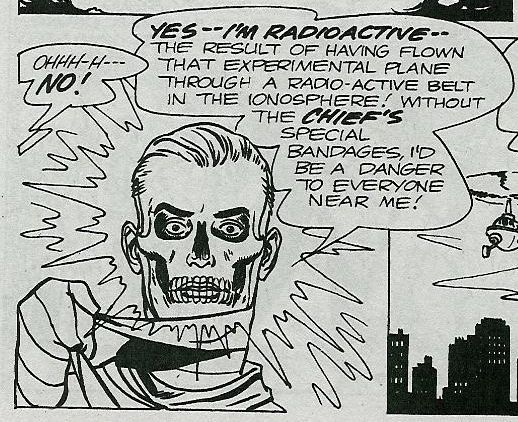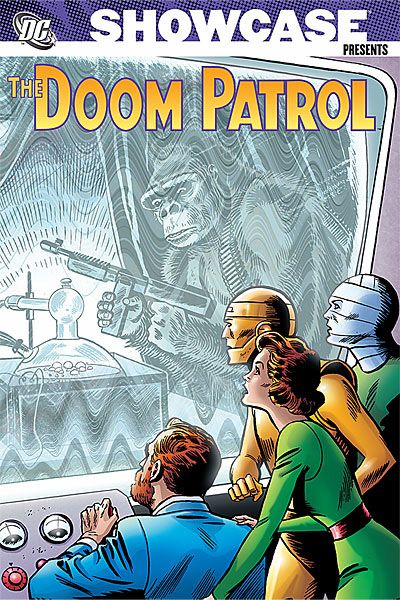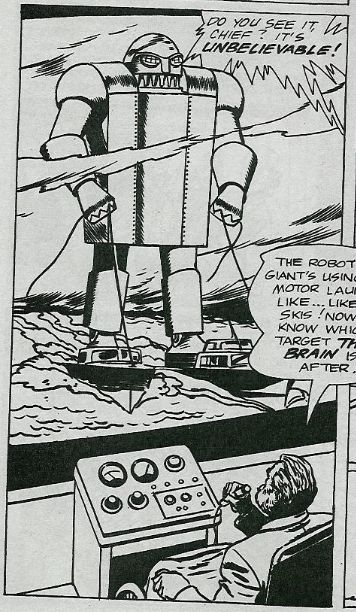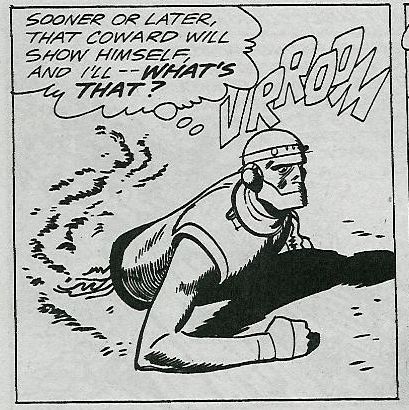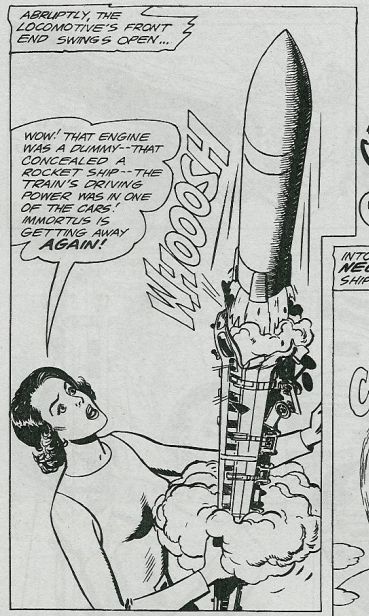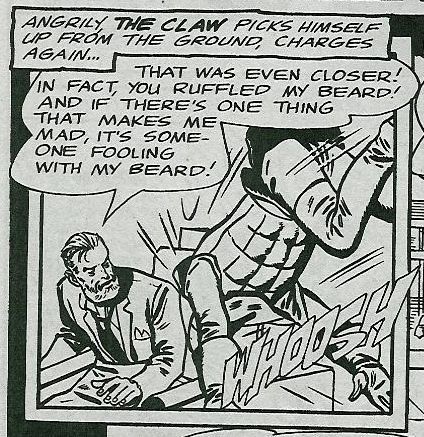Somewhere along the line, I became a huge Doom Patrol geek without even noticing. Buying Morrison's run in trade wasn't enough for me. No, I had to track down the vastly underrated Arcudi/Huat run. I'm champing at the bit for the upcoming Giffen-penned series. And now I've gone and read through all 500+ pages of Showcase Presents: Doom Patrol, a lovely collection of the first 21 issues of the team's original run by greats like Arnold Drake and Bruno Premiani. Simply put, it's the most fun I've ever had reading one of these phonebook-sized trades. The Onion's AV Club, however, only gave it a C+ grade. My opinion's a lot loftier than that.
Everyone always compares the Doom Patrol to the X-Men, and it's understandable why; they debuted within months of each other, they're both teams of super-freaks who just want to be loved and accepted, led by a man in a wheelchair, and they both fight Brotherhoods of Evil. I, however, always saw the Doom Patrol as more analogous to the Fantastic Four. Survivors of bizarre accidents who team up to fight weird menaces-- the tortured genius, the man in a monster's body, the high-flying energy dude, the shrinking violet? That's the FF all over. Despite how dysfunctional Stan Lee wrote the Fantastic Four, however, DC's Doom Patrol appears far more broken, neurotic, and just plain weird. They truly earn their title as the world's strangest heroes, and thanks to Arnold Drake and Bruno Premiani, the world around them becomes equally strange, and brilliantly so.
It's no secret that I think Arnold Drake is maybe the most underrated comics writer in the medium's history. When people think of early graphic novels, they think of Will Eisner, and when they dream of Silver Age craziness, they turn to Mort Weisinger, Gardner Fox, Julie Schwartz, Bobs Kanigher and Haney-- loads of zany creators, all. Few remember works like It Rhymes with Lust, or, naturally, the Doom Patrol, quite possibly the finest, most exciting Silver Age comic of them all. Luckily, we now live in the Golden Age of Comic Book Reprints, where anything fondly remembered, even by a select few, can live again for both new, fresh audiences, and older, wiser ones, ready to appreciate the work of Drake and Premiani.
The best part of Arnold Drake's storytelling in this volume is how he comes across as Stan Lee and Jack Kirby blended together in the body of one man. The character dynamics would feel right at home in the pages of the Fantastic Four-- the snipping but playful rivalry between Cliff and Larry, the unerring loyalty to the Chief, etc. These characters, however, live in the DC Universe, a mad fever dream of a world. Don't forget, this is a comic in which a man shoots his robot servant in the head to protect his secret origin; where a French paramilitary gorilla works for a talking brain in a jar; where jukeboxes come to life to destroy mankind; where a negative energy being made out of radio waves (everything in Drake's stories is done with radio waves; it's his cosmic ray, gamma ray, Kryptonite-- always ready with a "CRZZZ") bursts forth from the body of one of the main protagonists, and must return to him within 60 seconds, lest he die! Everything in the Doom Patrol is bigger, crazier, and more hysterical than anything dreamt up at ol' Marvel. Drake's dialogue leaps off the page. It's not all just his "mad ideas," his Animal-Vegetable-Mineral Men, plastic alien warlords, and guys with clocks for faces. It's lines like "Out of my way, Dr. Killpatient! I'm busting out of this freak factory!" You'll laugh maniacally reading this; old women will look at you funny, and gossip about that strange person to all their old lady friends.
I do not, of course, wish to downplay Bruno Premiani's fantastic artwork. Half the surreality of the stories derives from the artwork playing everything absolutely straight. Premiani lovingly renders every wrinkle and crag in the ancient General Immortus' face, and draws Monsieur Mallah as an actual gorilla-- one that just happens to talk and carry automatic weapons. The artist's facial work astounds here-- he ekes every last bit of emotion out of Cliff Steele's metal face and steamshovel jaw. Okay, so he just draws a face over Larry Trainor's bandages. We can forgive that, for everything looks so crisp and clean, so utterly refined. The lack of color in this volume only serves to improve the artwork! Black and white provides an immaculate look to Premiani's linework. The covers and occasional fill-ins from Bob Brown, meanwhile, sacrifice some detail work, but add a renewed sense of dynamism to the storytelling.
The characters are the ones that have to carry these gorgeous, occasionally insane stories, however, and our heroes carry them well. While they do have superhero codenames-- Robotman! Negative Man! Elasti-Girl!-- they would much rather refer to each other by their given names-- Cliff, Larry, Rita-- or cutesey nicknames, like "Stretch Socks." Underneath the bandages, below the metal, they're just people, after all. Drake and company add a couple characters to the mix as issues go by-- Mento comes by to help in a jam and hit on Rita; Beast Boy enters into the mix as the team's junior member. Neither of those guys, however, really fits into the cast as well as our core four.
Cliff Steele, being the mainstay of the group through its variations over the decades, would surely take the book over, right? Not exactly. Sure, he gets all the best lines, and comes off as, key to his character, the most normal, the most grounded, even if he's the most tragic. He's the reader's lightning rod-- our Ben Grimm, the man trapped in a body he's unfamiliar with, but who uses what he's been given to help out. If anything, I was surprised by how much he doesn't become the forefront of the book-- Larry and Rita solve many more problems than Cliff does. He gets what may be the best story in the book, though, with a back-up tale in which each of his robotic limbs is stripped away until he's only a torso and a head-- and he still manages to defeat his prey. Every issue or two, poor Cliff's metal body gets destroyed or wrecked in some bizarre way, but he's always as good as new by the next story. Drake could do terrible things to him-- and get away with it! I also dig how the apparatus on his chest is, in fact, a little camera so the Chief can keep up with the action.
Larry Trainor, on the other hand, is certainly the most freakish of the super-freaks. He doesn't just expel a negative being from his body to do his bidding-- he's also radioactive, translucent, and has to walk around wrapped in treated bandages all day. Combine that with his unrequited love for teammate Rita, and you've got the most unfortunate superhero ever created. So much of the Doom Patrol concept is wrapped up in body issues-- it's a book, after all, about a brain transplant survivor, a cripple, a woman who grow and shrink in all the right and wrong places-- but Larry bares the brunt of this body dysmorphism, forced to hide his true appearance, and unable to let his "inner self" out for too long without suffering deadly consequences. So many metaphors lie under those bandages-- we could be here all day.
Niles Caulder, the Chief, serves as the Professor X of the group, the wheelchaired mentor and leader who sends our team out into the field. He's not without his own capabilities, though-- he builds his "action chair" in order to join the fray when he must, and he wanders around as a cyborg for an issue. The characterization here is far from the more distant, nefarious version we'd get with Grant Morrison's run-- the Chief clearly loves his Doom Patrolmen, even if he's not quite sure how to express it.
Elasti-Girl appears the least freakish of the bunch-- a lovely woman in control of her powers-- but she starts as the shrinking violet, not just in powers but in personality. Drake could have easily subjugated Rita Farr into Sue Storm, who, you may remember, always turned invisible to avoid threats and was constantly treated as "just a woman," not only by her fellow teammates but by the guy writing the script, as well. Not so with Rita, however; she quickly becomes the most useful member of the team. While Cliff and Larry bicker or come up short, Rita gets the job done, time and again, quickly mastering her "Attack of the 50 Ft Woman" powers, and her Incredible Shrinking abilities. Indeed, something quite surprising is the sheer amount of phallic imagery concerning Elasti-Girl-- so many missiles end up looking like stand-in gentleman vegetables, swung around by a titanic woman! I guess it's fitting when the only girl on the team is the most macho member, leaping into the action every time, kicking the crap out of giant robots and other infernal monsters.
In fact, Freud would have the time of his life reading this comic. What is Robotman's predicament, after all, if not the ultimate form of penis envy? And Negative Man is permanently radioactive, unable to please a woman-- and that's doubled when he becomes jealous of his own negative being, the one who gets to join the fray while the helpless Larry Trainor looks on, weak as a kitten! Don't forget the Chief, either, who's dysfunctional below the waist and turns his attention instead toward building crazy machinery and assembling teams of superheroic misfits. It's probably no surprise all three of them were in love with Elast-Girl in some way. Man, you could write a thesis on these guys.
Yes, it took me a few weeks to work my way through the volume (and a considerably longer while to write the post), but I wanted to savor it. Showcase Presents Doom Patrol is that fine fat cigar you don't want to end-- and one that leaves you feeling sublimely lightheaded when you finish it.
If you're still not convinced, and need more Doom Patrol madness to win you over, look no further than Matt Fraction's multiple, lovely Arnold Drake tribute posts, "Everything I Needed to Learn about Comics I Learned from Arnold Drake," which start here and go on for a few pages. The panels he shows from later issues have me praying for another Showcase. Jesus! Allah! Buddha! Bring me another!

